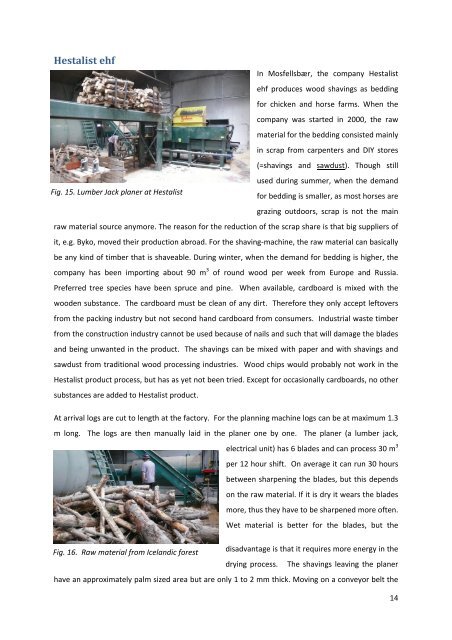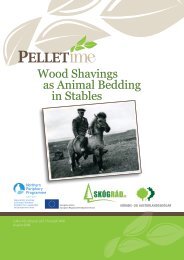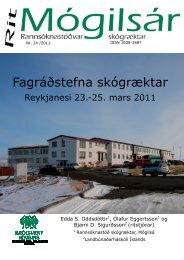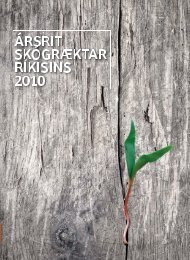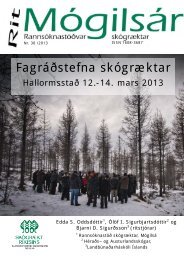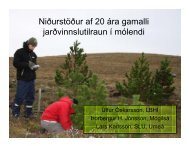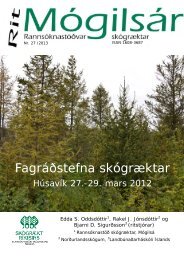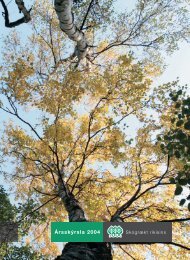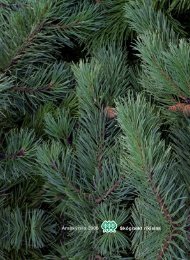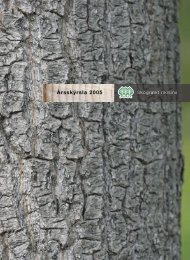Wood shavings as animal bedding in stables
Wood shavings as animal bedding in stables
Wood shavings as animal bedding in stables
You also want an ePaper? Increase the reach of your titles
YUMPU automatically turns print PDFs into web optimized ePapers that Google loves.
Hestalist ehfIn Mosfellsbær, the company Hestalistehf produces wood <strong>shav<strong>in</strong>gs</strong> <strong>as</strong> <strong>bedd<strong>in</strong>g</strong>for chicken and horse farms. When thecompany w<strong>as</strong> started <strong>in</strong> 2000, the rawmaterial for the <strong>bedd<strong>in</strong>g</strong> consisted ma<strong>in</strong>ly<strong>in</strong> scrap from carpenters and DIY stores(=<strong>shav<strong>in</strong>gs</strong> and sawdust). Though stillused dur<strong>in</strong>g summer, when the demandFig. 15. Lumber Jack planer at Hestalistfor <strong>bedd<strong>in</strong>g</strong> is smaller, <strong>as</strong> most horses aregraz<strong>in</strong>g outdoors, scrap is not the ma<strong>in</strong>raw material source anymore. The re<strong>as</strong>on for the reduction of the scrap share is that big suppliers ofit, e.g. Byko, moved their production abroad. For the shav<strong>in</strong>g‐mach<strong>in</strong>e, the raw material can b<strong>as</strong>icallybe any k<strong>in</strong>d of timber that is shaveable. Dur<strong>in</strong>g w<strong>in</strong>ter, when the demand for <strong>bedd<strong>in</strong>g</strong> is higher, thecompany h<strong>as</strong> been import<strong>in</strong>g about 90 m 3 of round wood per week from Europe and Russia.Preferred tree species have been spruce and p<strong>in</strong>e. When available, cardboard is mixed with thewooden substance. The cardboard must be clean of any dirt. Therefore they only accept leftoversfrom the pack<strong>in</strong>g <strong>in</strong>dustry but not second hand cardboard from consumers. Industrial w<strong>as</strong>te timberfrom the construction <strong>in</strong>dustry cannot be used because of nails and such that will damage the bladesand be<strong>in</strong>g unwanted <strong>in</strong> the product. The <strong>shav<strong>in</strong>gs</strong> can be mixed with paper and with <strong>shav<strong>in</strong>gs</strong> andsawdust from traditional wood process<strong>in</strong>g <strong>in</strong>dustries. <strong>Wood</strong> chips would probably not work <strong>in</strong> theHestalist product process, but h<strong>as</strong> <strong>as</strong> yet not been tried. Except for occ<strong>as</strong>ionally cardboards, no othersubstances are added to Hestalist product.At arrival logs are cut to length at the factory. For the plann<strong>in</strong>g mach<strong>in</strong>e logs can be at maximum 1.3m long. The logs are then manually laid <strong>in</strong> the planer one by one. The planer (a lumber jack,electrical unit) h<strong>as</strong> 6 blades and can process 30 m 3per 12 hour shift. On average it can run 30 hoursbetween sharpen<strong>in</strong>g the blades, but this dependson the raw material. If it is dry it wears the bladesmore, thus they have to be sharpened more often.Wet material is better for the blades, but theFig. 16. Raw material from Icelandic forestdisadvantage is that it requires more energy <strong>in</strong> thedry<strong>in</strong>g process. The <strong>shav<strong>in</strong>gs</strong> leav<strong>in</strong>g the planerhave an approximately palm sized area but are only 1 to 2 mm thick. Mov<strong>in</strong>g on a conveyor belt the14


